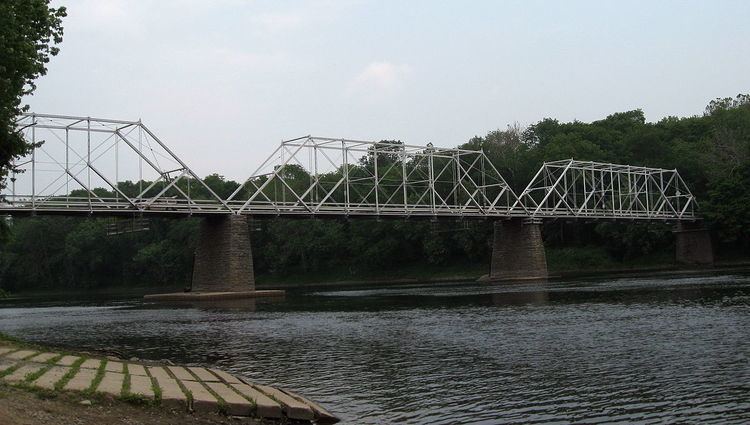Crosses Delaware River Other name(s) Dingman's Bridge Total length 162 m | Official name Dingman's Ferry Bridge Opened November 1900 Location Delaware Township | |
 | ||
Carries 2 lanes of PA SR 2019 and NJ County Route 560 Locale Delaware Township, Pike County, Pennsylvania Maintained by Dingmans Choice and Delaware Bridge Company Address RR 739, Dingmans Ferry, PA 18328, USA Owner Dingmans Choice and Delaware Bridge Company Similar Milford–Montague Toll Bridge, Dingmans Falls, Delaware Water Gap National, Portland–Columbia Toll Bridge, Delaware Water Gap Toll Bridge | ||
Dingman s ferry bridge eastbound
The Dingman's Ferry Bridge is the last privately owned toll bridge on the Delaware River and one of the last few in the United States. It is owned and operated by the Dingmans Choice and Delaware Bridge Company.
Contents
- Dingman s ferry bridge eastbound
- Dingman s ferry bridge 1973
- Origins
- First four bridges
- Later years
- Today
- References
Dingman s ferry bridge 1973
Origins
In 1735, Andrew Dingman, a Dutch pioneer from Kinderhook, New York, operated a ferry that connected the Old Mine Road in Sussex County, New Jersey to the Bethany Turnpike (now State Route 2019) in Delaware Township in Pike County. The ferry thrived for over a century as pioneers utilized this important river crossing to move westward. Crossing on the ferry took some time; the ferryman on the western (Pennsylvania) bank had to be summoned by a bell on the eastern (New Jersey) shore. A house was built near the present-day bridge in 1803 by Judge Daniel W. Dingman, who was said to hold court in his bare feet. Still standing, the house is on the state and national historic registers.
First four bridges
In 1836, the first bridge was built by the Dingmans. Under the terms of its charter, churchgoers, schoolchildren, and funeral processions were given free passage, a condition that is still in effect today. The first bridge lasted until 1847 when high water washed away the Milford Bridge upstream and swept the debris into Dingman's Bridge.
After a brief life, the second bridge was destroyed four or five years after the first, in a severe windstorm.
A third bridge was constructed in 1856, but, being of poor quality, it fell apart by 1862. The ferry was operated once again by the Dingmans until the property was sold in 1875 to John W. Kilsby, Sr. Kilsby's family operated the ferry until the turn of the twentieth century when the current bridge was constructed using some materials recycled from a railroad bridge on the Susquehanna River. This bridge has survived major floods in 1903, 1955, 2005, and 2006.
Later years
Dingman named his original plot of land Dingman's Choice. The village of Dingman's Choice, which became quite identified with the ferry, had its name changed by the Post Office to Dingman's Ferry in 1868. Records from an early log book show tolls of 40 cents for a horseless carriage, 25 cents for a two-horse wagon, 10 cents for a horse and rider, 5 cents for a bicycle, and 2 cents for a footman. Under the terms of the original charter, no toll was charged for individuals traveling to church or a funeral, a custom which is still practiced presently.
Today
Today, the bridge provides an important link for commuters to reach destinations in New Jersey and New York City. The bridge lies south of the current Milford Bridge, and well north of the Interstate 80 bridge at the Delaware Water Gap. As such, it is in a location which caters well to the commuter lifestyle of many area residents of Delaware Township, Dingman Township, and other surrounding communities.
Today's tolls are not much higher than previously noted. Automobiles pay $1.00. Books of forty coupons can be purchased from the toll collector for $30.00 as of 4/20/2015. This effectively lowers the toll to 75 cents if the entire book of coupons is used. Bicyclists may cross for free, but pedestrians are not allowed due to the narrow lanes. An 11-foot (3.4 m) height restriction coupled with a weight restriction of four tons precludes large RVs and trucks from crossing. Although the bridge is within the Delaware Water Gap National Recreation Area, government employees pay the toll, unless responding to an emergency with lights and sirens on. A breakdown of all current tolls can be found on the bridge's website. The bridge is one of only two bridges that charges a toll to enter New Jersey, along with the Delaware River-Turnpike Toll Bridge on the Pennsylvania and New Jersey Turnpikes.
Christmas Day is the only day of the year which finds the toll booth unmanned; everyone may cross for free. Dingman's Bridge is also remarkable in that there is a single toll collector who stands in between the single lanes of traffic, collecting toll fees by hand.
Because the Bridge Company is responsible for its own repairs, it employs an engineering firm certified for bridge inspection to regularly and thoroughly inspect the bridge from the tops of the trusses to the underwater foundations. Each year, the bridge company closes the bridge the second week after Labor Day to conduct any repairs needed to maintain the structural integrity of the bridge and to replace or flip the salt-treated B.C. fir planks. These floor boards are held in place with anchor plates and collar nails which results in a characteristic rattling of the deck with the traffic moving.
